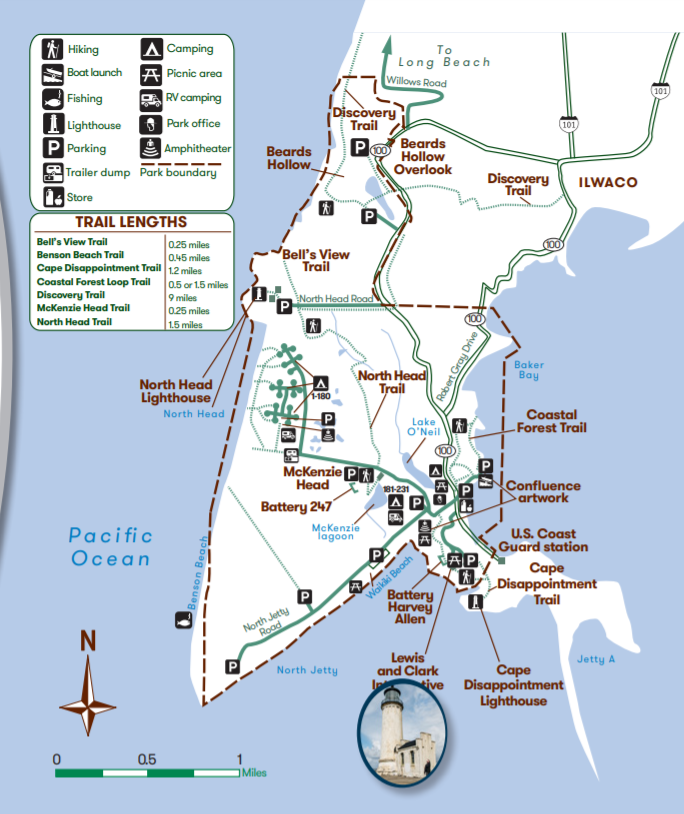
As someone who has travelled through over 20 states so far, Washington is by far the most beautiful, with a massive diversity of views between our wonderful beaches, both on the Puget Sound and the Pacific Ocean, our wonderful Cascade Mountain Range, and rugged desert like biome of the eastern part of our state and more. Cape Disappointment is anything but that, a wonderful camping park situated on one of the peninsulas to the far south west of Washington state, its only a few dozen miles from the Oregon state border.
This cape which is situated on the mouth of the Columbia River where it feeds into the Pacific Ocean is rich with wildlife, and magnificent natural views. The park offers yurts, cabins and unique historic vacation homes as well as camping grounds for whatever your fancy while you’re there may be. A main attraction of the park is boating on the coast and up the river, but besides that you can find: 8 miles of hiking trails; crabbing; fishing in fresh and salt water; clamming; bird watching and some indoor activities like exhibits and museums.
Cape Disappointment is drenched in rich history, dating back to the late 1700s. Cape Disappointment sits within the traditional territory of the Chinook tribe, who were known to be sophisticated traders and highly engaged in fur trades. Though the cape was first mapped by Spanish explorer Bruno de Hezeta in 1775, its naming is credited to English Captain John Meares, who found the cape in 1788, but could not locate the river’s entrance. Meares, therefore, named the headland Cape Disappointment. In 1792, American Captain Robert Gray successfully crossed the river’s bar and named the river “Columbia” after his ship, the Columbia Rediviva.
In 1805, the Lewis and Clark Expedition arrived at Cape Disappointment after their 18-month, 3,700-mile journey from St. Louis, Missouri. The Cape Disappointment Lighthouse was constructed in 1856 to warn mariners of the treacherous river bar where the Columbia meets the Pacific, known for its many shipwrecks as “the graveyard of the Pacific.” This is the oldest operating lighthouse in the Pacific Northwest. In 1898, the North Head Lighthouse was completed, due to the original lighthouse being difficult to spot from the north side.
In 1862, Cape Disappointment was armed with smoothbore cannons to protect the mouth of the Columbia River from Civil War threats. The installation was expanded to become Fort Canby in 1875, named for Army General Edward Canby. The fort continued to be improved until the end of World War II Gun batteries and other structures still sit on the cliffs overlooking the Pacific Ocean.
In 1912, the U.S. Army Corps of Engineers arrived at Cape Disappointment for construction of the North Jetty at the entrance to the Columbia River. With the South Jetty in Oregon, the jetties provided for safer navigation of the Columbia River bar. The 2.5-mile long,
three million ton, stone structure was completed in 1917. Cape Disappointment also housed a Civilian Conservation Corps camp from 1935 to 1938. The men enrolled in the program restored the fort and improved roads and trails. In 1938, the first parcel of land, known locally as “Bell’s View,” was purchased for $1 by Washington State Parks for what would become Cape Disappointment State Park.
History buffs will absolutely adore the history that you can observe here in person, up close. Many sites are open for exploration and viewing, including a Lewis and Clark Interpretive Center, historic Civil War era fortifications and weaponry, and other buildings including the lighthouses themselves which still stand proud. Fishing here is INCREDIBLE during legal times around Salmon spawning season, you can fish Coho and King Salmon, as well as Steelhead trout, halibut, or Dungeness crab. So before heading down for a weekend of shoreline outdoor activities, be sure to stop by your local House of Cannabis and stock up on your chronic. Until next time.
-Kyle Heiderich
Article Author
